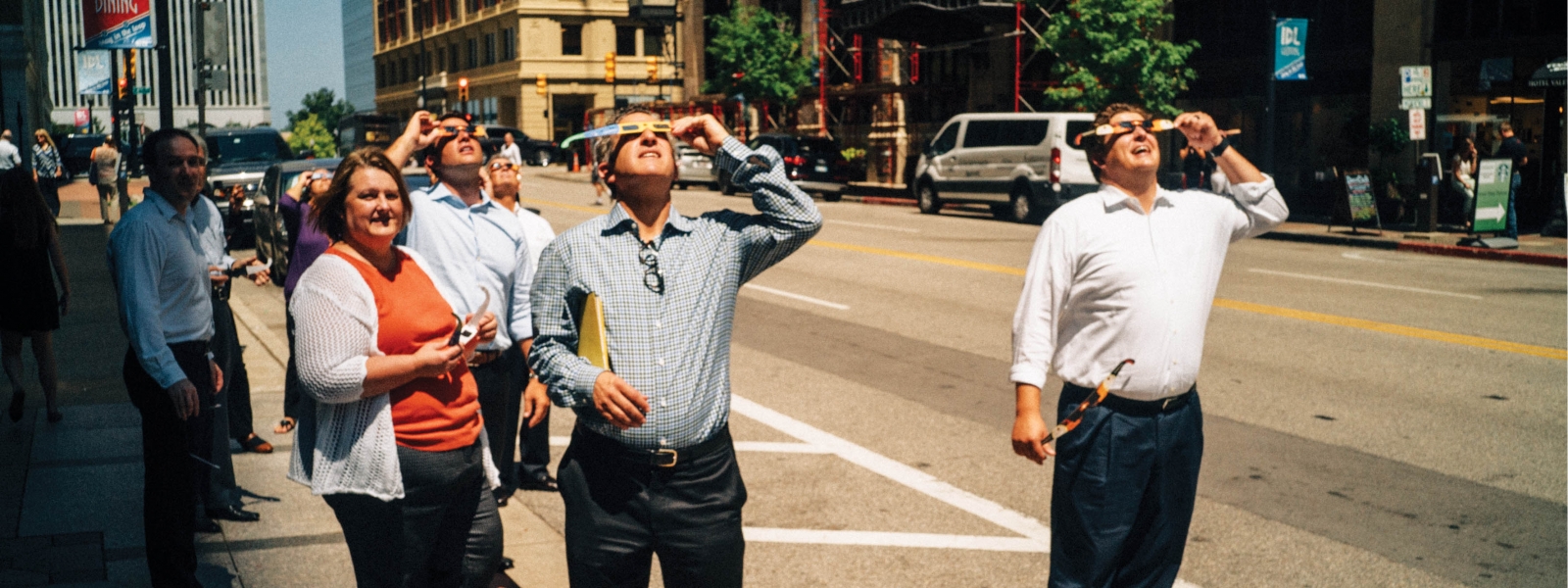America under darkness
Totality and penumbra in the Midwest
Jeremy Charles
On August 21, two friends and I approached Ravenna, Nebraska after driving past dozens of eclipse viewing parties strewn along NE highways. The edges of towns were quarantined areas for visitors and vendors, astronomic tourists were parked between cornfields, and rest areas were overfull.
Lincoln was far behind in our rearview mirror, under cloud cover, so too was Homestead National Monument near Beatrice—where we had originally planned to stop, and where Bill Nye would view the eclipse from—but with the help of a map and radar, we turned past Ravenna’s “Pop. 1,360” road sign under clear skies and stopped nearly dead center on the path of totality.
Back in Tulsa, events were hosted all over town, including at Turkey Mountain, STEMcell Science Shop in the Boxyard, and the Central Library.
“It really caught fire,” said Ryan Howell, events coordinator at Tulsa River Parks Authority. “We got more social media response than we’ve gotten for anything we’ve ever done.”
I heard similar stories from Terry Mudge, owner of The STEMcell, and from Jessica Sanchez, teen library associate at Tulsa City-County Central Library.
Howell, Mudge, and Sanchez each estimated their turnouts at over 500, though official counts were not taken. Free eclipse glasses were available at all three locations—in the preceding days STEMcell sold out several times over, but unclaimed glasses on reserve were handed out near the eclipse’s peak time. Howell’s wife, Katie Gillies, operated a telescope with solar filter, allowing many a closer look. At the library, they gave away laser cut pinhole projectors, fabricated in their Maker Space. They also broadcast NASA’s live stream of the eclipse inside the library and outside in the garden.

Tulsans saw peak coverage of 88.7 percent at 1:08 p.m. The next total solar eclipse is in seven years and will pass through southeast Oklahoma. On August 12, 2045, Tulsa will be directly in the path of totality.
“It’s good to see that everyone is still interested in natural phenomenon that’s explainable with science,” Mudge said.
“The sun is so freaking big and the moon is so freaking small, but they’re at such appropriate distances from us that they appear to be the same exact size in the sky, so you get that total eclipse where you can see just the corona of the sun. You won’t get that on another planet.”
At Ravenna’s Hometown Eclipse Festival, hundreds of locals and tourists were assembled on a baseball field in the middle of the small town. Everyone was easygoing. The more serious hobby-astronomers had their telescopes ready, others sat in lawn chairs or laid on the grass. The line at the snow cone shack was long and the PA system washed country music over us.
As the eclipse came on, shadows sharpened, and the crescent shapes cast through trees cut thinner and thinner. Everything faded in color like a rapid sunset until the sky was dusk-yellow. The wind picked up in a cool breeze. It was eerie. Looking up, there was only the faintest sliver of sun peeking from behind the moon. When the last diamond of direct sunlight disappeared, it was like a switch flipped. Hazy darkness fell immediately and the corona illuminated above. Everyone cheered, gasping in amazement, and then all fell silent.
For two minutes and thirty-five seconds, we marveled at the grisaille twilight around us, beholding a white ring in the sky that started down on us like an ancient eye. As the sun, moon, and earth aligned, we witnessed something greater than any of us, or all of us combined. It felt like balance, a brief moment of peace.
Then the moon passed to the other side and the sky burst with light again. As the scene gradually brightened, roosters crowed across the street


.jpg)
.jpg)
